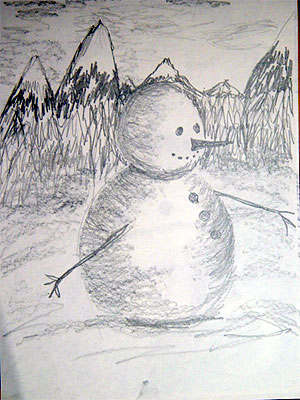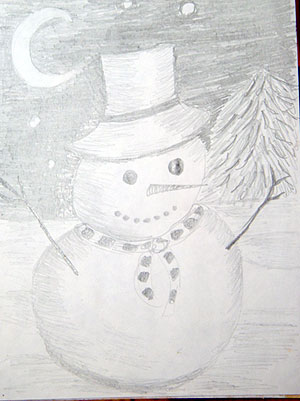Fourth Grade Art Lesson 23
Chalk Drawing a Snowman, Part 2 Re-drawing Our Snowman with Pencil
Objective:
The student will learn how different media affects the results of their work by copying their chalk drawing with pencil. The students will be aware of the use of the art elements value, form and space into their drawing.
Materials:
snowman chalk drawing, white paper, pencil
Procedure:
Creating art requires not only an understanding of a subject but also an understanding of the material. We completed our snowman drawing using chalk pastels. I wanted you to see how to make cool colors as well as to create a fun imaginary drawing. Today I want you to see how the same drawing would look if it were in black and white. I want you to copy your snowman drawing using a pencil. You will need to recall the information we learned in the beginning of this program about value, form and space. You will incorporate each of these art elements into this drawing, just as you did in the chalk drawing, only you will have to maximize the use of each of these elements because you do not have the benefit of color. Begin by lightly outlining the composition. Do not press hard with your pencil so you can easily erase any mistakes, and to help you best utilize value. Once you have the composition in place, focus on your use of space. Identify the foreground, middle ground and background. The background should be higher up on your paper than either the foreground or middle ground. Where is your snowman? Because the snowman is the focal point of the work it should be in the foreground or middle ground. Is there anything behind the snowman? If not, should there be? Regardless what you put in the background, it should be drawn smaller than the snowman. Even if it is a house! Do you have any trees in your drawing? When you draw trees with your pencil, avoid outlining and build up the texture both on the trunk and in the branches. Background trees are much easier because they do not require as much detail as closer trees. When you feel the space is filled satisfactorily, begin working on your value. Value is what will make the snowman look like a form. Do you remember turning blob shapes into form by coloring them in with a wide range of value? Even though your snowman is made out of white snow, you will need to use a full range of value to convince the viewer that the snowman is in fact a snowman. Be sure to pay close attention to the side of your hand. As you build up the value (graphite) your hand will pick it up and if you are not paying attention you will put hand stamp prints all over your paper. Work diligently on your drawing and do not rush it.
Conclusion:
Before you call your drawing finished, ask yourself the following questions. Does my work look complete all over? Can I find a wide range of value in my work which makes the objects look three dimensional (forms)? Have I shown space in an interesting way and used the principles of creating distance in my drawing such as making objects further away smaller and with less detail? Compare your pencil drawing with your chalk drawing. Which do you like the best? Why?
Artwork and Examples used in this lesson

Teacher Example

Student Artwork













